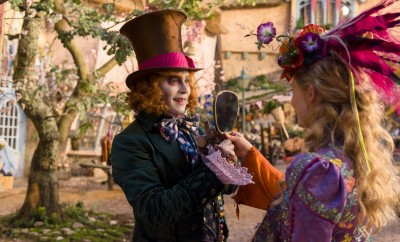
Lewis Carroll’s “Alice’s Adventures in Wonderland” and “Through the Looking-Glass” are a pair of tales as old as time — 151 years old in the case of the former and 145 in the case of the latter, to be exact. James Bobin, director of “Alice Through the Looking Glass,” puts a new spin on the beloved, classic tale by taking us on a time warp through the magical history and world of Underland.
The film, which follows Tim Burton’s “Alice in Wonderland,” is equal parts prequel and sequel. With elements of the books combined with an original story written by Linda Woolverton, Alice (Mia Wasikowska) returns to the whimsical Underland and travels back in time on a quest to save the Mad Hatter (Johnny Depp). Along the way, she encounters friends and enemies, both old and new, and takes us to new parts of the fantastical realm.
For both Alice and Bobin, time is of the essence, and it’s a motif that is weaved throughout the film.
Audiences are introduced to Time (Sacha Baron Cohen), a half-clockwork, half-human demigod who has the ability to travel back and forth in time through different eras with a special skill concealed in a device called a chromosphere.
“In terms of new characters, I was very keen to introduce people to characters who felt like they were of this world,” Bobin said in a conference call interview. “Time is really Lewis Carroll’s idea. When Hatter first meets Time, he says, ‘I’ve been stuck in the tea party since last month, when Time and I quarreled.’ And I thought, ‘Oh, that’s a good idea for a character and one that was in Lewis Carroll’s mind.’”
But don’t immediately write off Time as the ultimate antagonist — that crown still goes to the Red Queen (Helena Bonham Carter). Time is a complex character that mirrors the gray zone of what it means to be good or bad, Bobin said.
“It was very important to me that for the character, you actually felt sorry for him, because I like the idea that Time is lonely,” he said. “And yet at the same time, I wanted him to be likable.”
The integration of new characters like Time and Zanik Hightopp (Rhys Ifans) is just one of several ways in which Bobin was able to contribute his vision to the striking world that Burton established.
“When it comes to creating a film that’s a sequel, you have to stay true to the original design,” Bobin said. “But at the same time, I was able to do things because the movie was set in a different place and in a different time. [Underland] has that feeling of having been lived in for a very long time, and that was very important to me. I love the idea of a place and how it changes through time.”
Bobin’s interest in history naturally found its way to the development of new settings like the magical Wit’s End, where the Mad Hatter’s family has a hat shop and where the Red Queen and White Queen (Anne Hathaway) grew up. The town, as Bobin put it, “is a kind of mixture between a cob’s world in England and an old town in Dubrovnik.”
As the film’s central backdrop, Wit’s End whisks viewers away to a time when essential characters were not always who they seemed to be.
“I love ideas exploring why people are how they are,” Bobin said. “You are aware of the responsibility attached because everyone loves these characters. So the only thing you can do in this situation is stay true to your own sense of who they are, how they behave and what they mean in the space that they occupy in a world like that.
“It’s a responsibility. But at the same time, it felt like it had been around for a while, so I wanted to reintroduce them, in a way.”

















































































































